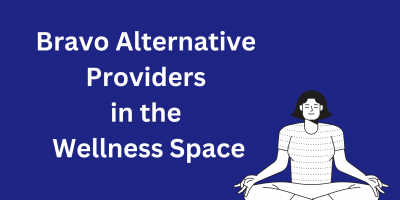
Bravo Alternative Providers in the Wellness Space
Bravo may be a comprehensive provider, but the following wellness alternatives introduce features, tools, and focus areas that address a broad spectrum of employee needs and employer objectives.

The mental and physical health of employees has reached an unprecedented low point.
Collectively, American companies invest billions of dollars each year in addressing employee health issues linked to sedentary lifestyles, obesity, smoking, poor nutrition, stress, diabetes, and other modifiable risk factors.
While the concept of wellness is not new, we have a more comprehensive and sophisticated view of it today. Wellness now encompasses not only fitness and nutrition but also overall social, financial, and mental health.
Recognizing the vital role of a wellness-oriented corporate culture, forward-thinking companies increasingly embrace its importance in today’s business landscape. A company culture that prioritizes employee health and well-being over the traditional focus on productivity and profits enables enhanced performance, engagement, and job satisfaction.
This article delves into the key elements and actionable steps involved in developing a culture of wellness in the workplace. It provides practical strategies and best practices for organizations to cultivate a thriving and holistic work environment.



A culture of wellness in the workplace is more than a corporate trend or a way to stay competitive. It is a genuine commitment to the overall well-being of employees because employers understand that healthy employees are more productive, engaged, and loyal.
While your company may pride itself on being a good employer, it’s crucial to recognize how work design can unintentionally harm employees’ health and well-being. The reality is that working conditions and the demands of the work environment often serve as significant sources of stress for many Americans.
For example, a worker juggling three roles, a manager overwhelmed with direct reports, or a burned-out, underpaid employee may not be able to improve their well-being simply by exercising or using a stress-management app.
For this reason, organizations must reassess outdated beliefs that inadvertently impact employee well-being in the workplace. Considering that employees spend a significant portion of their waking hours in the workplace, the culture there profoundly affects their happiness.
In the pursuit of wellness, it falls upon companies not only to recognize potential risk factors but also to inspire and assist their employees in attaining their wellness objectives.
Globally, four out of five HR leaders prioritize mental health and well-being in their organizations. This is no surprise, as businesses increasingly embrace innovative approaches to support employee health and shape a positive employee experience.

For instance, Google is renowned for its comprehensive wellness programs, including on-site gyms, free healthy meals, and meditation classes. Netflix is known for its relaxed and supportive work environment, while LinkedIn focuses on mental health by providing counseling services and mindfulness workshops.
In fact, around 90% of organizations worldwide offer some form of employee wellness benefit.
But why is wellness at work important? And what are the benefits of wellness programs at work?
Companies can reap numerous benefits by prioritizing employee well-being and implementing wellness programs.
Organizations that foster a wellness-oriented culture tend to have higher levels of employee satisfaction and engagement. Even if not all employees engage in corporate wellness programs, they still send a valuable message: that the company values its people and provides resources to support their well-being.
An American Psychological Association study found that employees with access to health and wellness offerings are more likely to report feeling healthy and satisfied with their jobs.
When employees feel their well-being is valued, they experience greater job satisfaction, leading to increased loyalty and commitment to the company.
Research consistently demonstrates that employees who prioritize their well-being are more productive and perform better. Employee wellness statistics show that employees who feel well and engaged are 13% more productive than those who do not.
Moreover, research conducted by Gallup highlights that employees who are already engaged in their work exhibit even greater performance outcomes when physical wellness programming is incorporated into the workplace culture.
By investing in wellness initiatives, such as fitness programs, mental health support, and work-life balance initiatives, organizations can enhance employee focus, creativity, and overall performance.

Attracting and retaining top talent is crucial in today’s competitive job market. A wellness-oriented corporate culture is a powerful tool for building a talented workforce.
According to a study by the Harvard Business Review, companies with wellness-oriented cultures have 30% lower absenteeism rates and 20% lower turnover rates than companies without such cultures.
This is because prospective employees are more likely to be drawn to companies that prioritize employee well-being, as it reflects a positive work environment. Existing employees are also more likely to stay with an organization that demonstrates a genuine commitment to their health and well-being.

Companies can play a crucial role in lowering healthcare costs by promoting wellness and preventive care. Research indicates that individuals who exercise regularly, practice stress management techniques, and maintain a healthy lifestyle are less prone to developing chronic conditions.
Implementing employee well-being campaigns can significantly contribute to reducing healthcare utilization, decreasing absenteeism caused by illness, and ultimately curbing medical expenses for the organization. For instance, one study found that workplace interventions can effectively lead to improvements in diet, further supporting the positive impact of wellness initiatives.
The question of who is responsible for wellness at work is a complex one. Traditionally, the human resources (HR) department has been seen as the owner of this responsibility.
However, in recent years, there has been a growing recognition that wellness is not just an individual issue, but also a systemic one. This means that it requires the engagement and commitment of all levels of an organization, from the C-suite to the frontline employee.
Creating a wellness-oriented corporate culture entails incorporating several key elements, including:

In order to support well-being in the evolving landscape of work, leaders and companies must embrace progressive thinking and implement creative solutions. Developing a culture of wellness requires a strategic and holistic approach that nurtures a healthy environment and fosters beneficial habits, both personally and professionally.
There are many ways that businesses can promote a wellness-oriented corporate culture in the workplace. Here are a few practical steps:
When it comes to wellness programs, many companies make the mistake of adopting a fragmented approach to wellness programs by focusing on individual initiatives, such as offering on-site yoga classes or providing employees with gym memberships. However, these programs are often disconnected from the larger corporate culture, and, as a result, they are not as effective as they could be.
As this article suggests, a genuinely successful wellness program must be rooted in the company culture. This means that the organization’s values must be aligned with the wellness program’s goals. For example, if a company values creativity and innovation, then its wellness program should focus on activities that promote those qualities.
A workplace wellness policy is a written document that outlines the company’s commitment to wellness and sets forth specific goals and initiatives. The policy should be clear, concise, and easy to understand.
When developing the policy, it is essential to get input from employees. Once the policy is in place, promoting it throughout the organization is just as important. This can be done through employee communications, training, and other methods.
Employee expectations for wellness programs are constantly changing. They are no longer satisfied with the traditional offerings of on-site fitness facilities and employee assistance programs. They want novel methods, new approaches, and unique responses.
To meet these changing expectations, businesses must offer various wellness programs that appeal to a wide range of employees. Some examples of innovative wellness companies’ offerings include:
Many employees may not know where to start when it comes to their own wellness. By providing educational resources and raising awareness about wellness, companies can help employees make informed choices about their health. This could include things like providing information about healthy eating, exercise, and stress management. It could also involve hosting wellness seminars and workshops.
Wellness programs should be convenient and easy for employees to participate in. This means offering programs during work hours, providing transportation to and from events, and making resources available in a variety of formats.
A recent survey found that more than two-thirds (68%) of workers did not use the full value of their organizations’ well-being resources because accessing programs was either too time-consuming, confusing, or cumbersome.
It is vital to measure the results of wellness programs to see what is working and what needs improvement. Businesses can measure wellness program results by tracking employee health metrics, absenteeism rates, and productivity levels.
In addition to these traditional metrics, businesses can also use more innovative metrics to measure the results of their wellness programs in a meaningful way. For example, organizations should focus on measuring both the return on investment (ROI) and the value generated (VOI).
When employees achieve their wellness goals, it’s important to celebrate and reward their successes. This could be done through monetary incentives, such as gift cards or discounts on health club memberships.
It could also be done through non-monetary incentives, such as recognition at company meetings or the opportunity to participate in special wellness events.
As we conclude, it is crucial to reiterate the significance of a wellness-oriented corporate culture. Well-being is not only essential for employee happiness and fulfillment but also has a direct impact on business outcomes.
Recognizing the interconnectedness of everyone in the workplace is vital when introducing wellness programs and initiatives.
In conclusion, by nurturing a culture that prioritizes well-being, organizations can create an environment where employees thrive, resulting in mutual success for both individuals and the company.
Disclosure: Some of the products featured in this blog post may come from our partners who compensate us. This might influence the selection of products we feature and their placement and presentation on the page. However, it does not impact our evaluations; our opinions are our own. The information provided in this post is for general informational purposes only.
Senior Content Writer at Shortlister
Browse our curated list of vendors to find the best solution for your needs.
Subscribe to our newsletter for the latest trends, expert tips, and workplace insights!

Bravo may be a comprehensive provider, but the following wellness alternatives introduce features, tools, and focus areas that address a broad spectrum of employee needs and employer objectives.

Beyond step counters and group exercise, corporate fitness challenges inspire movement in the company’s bottom line, but only when done right.

Explore crucial employee wellness statistics to enhance workplace well-being and productivity.

If you think a ping-pong table and massage chairs will make employees find long-lasting fulfillment at work, think again.
Used by most of the top employee benefits consultants in the US, Shortlister is where you can find, research and select HR and benefits vendors for your clients.
Shortlister helps you reach your ideal prospects. Claim your free account to control your message and receive employer, consultant and health plan leads.